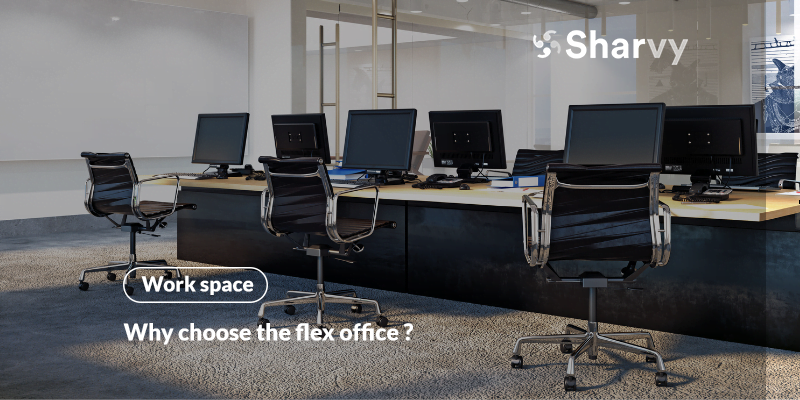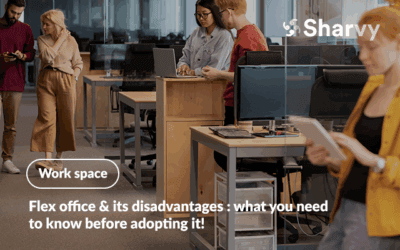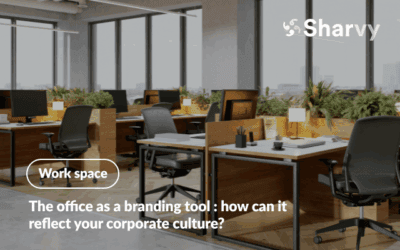The professional world is increasingly moving towards a hybrid working environment, where employees alternate between days on the job and teleworking. In this context, the flex office is gradually becoming established within companies to absorb the changes that punctuate our daily lives effectively.
It is now emerging as an architectural masterpiece in workspace design. Far removed from the static conventions of traditional offices, the flex office embodies a bold revolution, redefining the contours of productivity, creativity, and professional well-being.
But what is it, and what are the advantages of implementing this type of work organization? Find out in this article!
What is the flex office?
The idea of the flex office (or flex desk) initially arose from the fact that not all company employees are always at their desks simultaneously. Between holidays, teleworking, travel, and meetings, a named workstation is never used 100% daily. According to CBRE, it is accessible around 40% of the time, even more so due to the strong growth in teleworking and flexible working in recent months.
The flex office offers employees a degree of freedom. They don’t have to sit in the same place every day. They no longer have a dedicated desk. They can, therefore, change location according to their tasks and desires: a desk in an open space, setting up in a corpoworking area, on a table in the cafeteria, in a hot-desking zone, etc. It’s a way of organizing work that overturns the codes of more traditional organizations, with individual and nominative offices in particular.
However, the flex office cannot be improvised because it impacts the work organization. It has to be learned, practiced, and implemented step by step. Our guide’s aim is below: benefits, prerequisites, risks, best practices, and feedback from various sources. We’ve outlined the 8 golden rules you need to follow to make your transition to a flex office successful!
What are the benefits?
With its innovative concept of flexibility in the use of workspaces, the flex office is emerging as a paradigm conducive to both the well-being of employees and the operational efficiency of companies. Far from being just a passing trend, it offers a range of crucial advantages, both individually and collectively, redefining the traditional conception of working environments.
1. Benefits for the employee.
On the one hand, the flex office gives employees unprecedented freedom in their choice of workspace. By opting for various workstations, from shared offices to relaxation areas, they can adapt their environment to suit their tasks and preferences, thereby promoting a balance between individual concentration and collaboration.
What’s more, the variety of spaces offered in the flex office allows employees to diversify their daily working lives. From quiet areas for concentration to collaborative spaces for creativity, this flexibility contributes to psychological well-being and quality of life at work.
Moreover, this way of organizing work encourages employees to be autonomous and responsible for managing their workspace. They become active players in their professional environment, which can stimulate individual initiative and strengthen the sense of belonging.
And, when teleworking is gaining importance, the flex office is in line with new working standards. It enables a fluid transition between the physical office and other workplaces, promoting the adaptability that is essential in today’s working world.
2. Benefits for the company.
On the corporate side, the flex office enables more efficient use of office space by adapting resources to actual needs. This can lead to substantial savings by reducing property costs and optimizing the use of existing infrastructure. In effect, offices are no longer named by name, and the company can determine an appropriate desk-sharing ratio. As a result, several employees use the same space alternately, depending on when they are on site.
At the same time, the diversity of workspaces encourages collaboration between teams. From informal meeting areas to open spaces dedicated to innovation, the flex office encourages spontaneous exchanges, stimulating creativity and productivity.
It also offers employees a flexible working environment, a significant asset in attracting talent and retaining staff. Companies adopting the flex office demonstrate a sensitivity to the changing needs of their teams, thereby enhancing their attractiveness in the labor market.
Finally, the flexibility inherent in flex office gives companies invaluable agility. They can quickly adjust their spatial organization in line with internal developments, specific projects, or new market trends, strengthening their ability to adapt to a changing professional environment.
In conclusion
In short, by offering flexibility to employees and companies, the flex office is a fundamental strategic approach to redefining workspaces. This symbiosis between individual well-being and organizational optimization helps to forge dynamic working environments conducive to talent development and the overall success of businesses in a constantly changing professional landscape.
Have a question ? Check out the FAQ !
What challenges might companies face when implementing flex office?
Implementing flex office in a company can present several challenges. One of the primary challenges is change management, as this model disrupts the habits of employees who are used to having a fixed desk. It’s crucial to prepare teams thoroughly for this new organization to avoid resistance and misunderstandings.
Additionally, adapting the work environments is essential: it’s important to ensure that collaborative spaces are well-designed to promote well-being at work while allowing for optimal flexibility. Poor management of these new spaces can lead to issues with productivity and employee satisfaction.
Finally, integrating the necessary technologies for effective collaborative work, such as space reservation systems and digital communication tools, is another significant challenge. It’s vital to choose the right tools and ensure that all employees are trained in their use to guarantee the success of the flex office.
Want to learn more? Check out our latest articles!
Flex office & its disadvantages : what you need to know before adopting it!
What is the flex office? How does it work? What are its drawbacks and how can you overcome them? Find the answers in this article!
The office as a branding tool : how can it reflect your corporate culture?
Is the office an underestimated branding tool? How can your spaces embody your culture & reinforce your brand image? Focus!
Flexible office solutions : how to adapt them to all generations ?
How can flexible office solutions adapt to the needs of different generations? What are the best strategies to implement? Focus!
Subscribe to our newsletter!
Resources
Contact us
+44 117 463 6990






